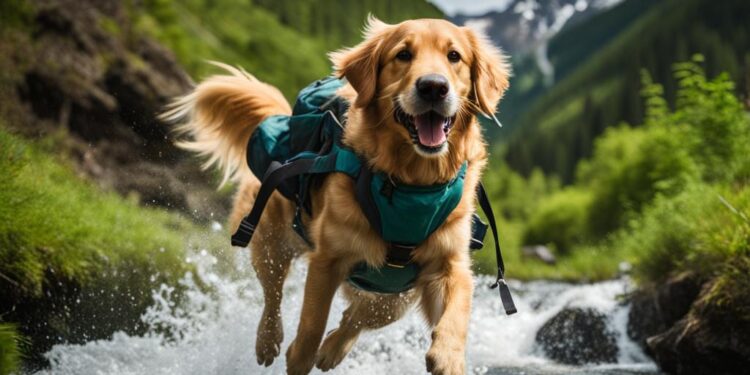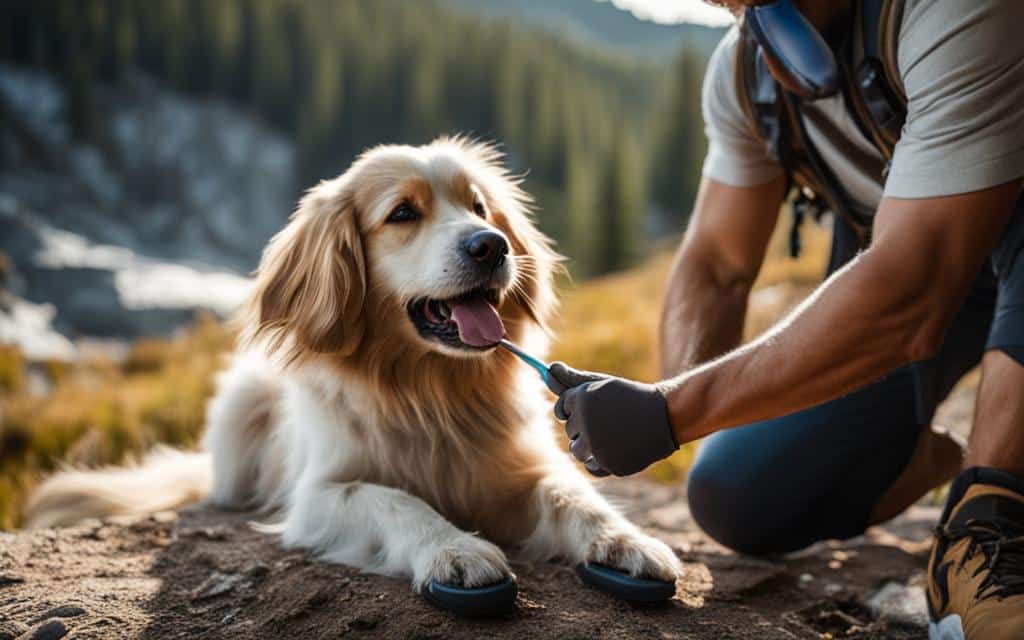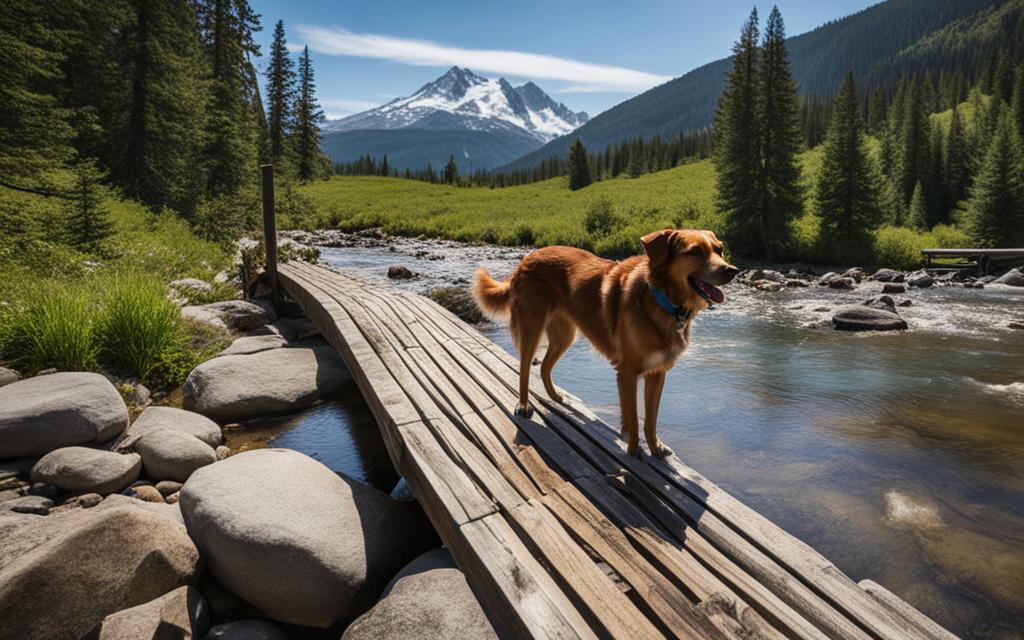The Ultimate Guide to Hiking with Your Dog

Hiking with your dog is a fantastic way to enjoy the great outdoors and create lasting memories with your four-legged companion. Whether you’re exploring scenic trails or tackling challenging terrain, the adventure of dog hiking offers countless benefits for both you and your furry friend.
To make your dog a great hiking partner, there are important considerations and steps to take before hitting the trail. By following proper preparation, ensuring your dog’s safety, and practicing responsible trail etiquette, you can embark on unforgettable outdoor adventures with your dog.
Key Takeaways:
- Prepare your dog for hiking by consulting with your veterinarian and assessing their age, body type, health, and vaccinations.
- Build your dog’s stamina through regular exercise and gradually increase the difficulty of their hikes.
- Condition their paws for tough terrain with gradual adjustment and consider using paw protection salve.
- Bring essential items like water, portable water dish, pet first aid kit, collar and leash, and poop bags.
- Follow proper trail etiquette, including leash requirements, respecting wildlife, and practicing “leave no trace” principles.
Get a health assessment
Before embarking on a hike with your dog, it’s crucial to have a health assessment for them. Consult with your veterinarian to determine if your dog’s age, body type, and overall health make them suitable for hiking.
Older or younger dogs may not have the stamina required for extensive hikes, and certain body types, such as brachycephalic breeds, may struggle with breathing during intense physical activity. Dogs with health issues or excess weight may also not be fit enough for hiking.
Additionally, ensure your dog’s vaccinations are up-to-date and discuss preventive measures for fleas, ticks, and waterborne pathogens with your vet.
Benefits of a Health Assessment
A comprehensive health assessment by a veterinarian is vital before embarking on a hiking adventure with your dog. Here are some key reasons why:
- Assessing your dog’s age: Young puppies or senior dogs may not have the physical capacity for long hikes. Understanding their age-related limitations can help determine appropriate hiking distances and durations.
- Evaluating your dog’s body type: Different dog breeds have varying physical traits, which may impact their ability to handle strenuous hikes. For example, brachycephalic breeds, like Bulldogs and Pugs, may struggle with breathing difficulties during intense physical activity.
- Considering your dog’s overall health: Dogs with pre-existing medical conditions, such as heart disease or arthritis, may need special attention and modifications to ensure a safe and enjoyable hiking experience.
- Ensuring up-to-date vaccinations: Hiking trails often expose dogs to various environmental risks, including encounters with wildlife and potential exposure to infectious diseases. Ensuring your dog’s vaccinations are current can help protect them from preventable illnesses.
A thorough health assessment will give you a clear understanding of your dog’s physical capabilities and any potential health risks. With this knowledge, you can make informed decisions and take necessary precautions to ensure a safe and enjoyable hiking experience for both you and your furry companion.
Preventive Measures
During the health assessment, discuss preventive measures with your veterinarian to protect your dog’s well-being during hikes:
- Fleas and ticks: Ask about preventive treatments to prevent infestations and minimize the risk of tick-borne diseases.
- Waterborne pathogens: If there are water sources on your hiking trails, inquire about preventive measures for waterborne diseases, such as leptospirosis.
By addressing your dog’s health and vaccination needs before hiking, you can ensure their safety and reduce the chances of potential health issues along the way.
| Considerations | Benefits |
|---|---|
| Dog’s Age | Determines physical capacity for hikes |
| Dog’s Body Type | Identifies breed-specific limitations |
| Dog’s Health | Highlights pre-existing conditions |
| Dog’s Vaccinations | Protects against infectious diseases |
Prepare your dog for the hike
It’s essential to prepare your dog for the hike, even if they are in good physical health. Here are some key steps to ensure your dog is ready for the adventures that lie ahead:
- Build up stamina: Regular exercise is crucial to build your dog’s endurance. Start with short walks and gradually increase the duration and difficulty of the hikes. This will help your dog develop the necessary stamina for longer treks.
- Practice with small hikes: Before embarking on a challenging trail, start by going on shorter and less strenuous hikes. This will allow your dog to become familiar with the hiking environment and gradually adapt to the physical demands of the activity.
- Prep paws for trek: Your dog’s paws need to be conditioned for rough terrain. Slowly introduce them to different surfaces and increase the intensity over time. Consider using hiking booties or applying paw protection salve to minimize discomfort and prevent injuries.
- Experiment with a dog backpack: If appropriate for your dog’s size and ability, consider having them carry their own supplies in a dog backpack. It’s essential to consult with your vet about the proper weight distribution and ensure your dog is comfortable with the added load.
- Practice training cues: Training your dog with basic obedience commands is crucial for their safety and enjoyment during the hike. Make sure they respond well to cues such as “sit,” “stay,” and “leave it.” Reinforce these commands during your training sessions so your dog becomes familiar with them in various hiking situations.
By following these preparation steps, you’ll ensure that your dog is physically and mentally ready for the adventure ahead. Remember to always prioritize their well-being and comfort throughout the hiking journey.
| Preparation Tips: | Benefits: |
|---|---|
| Build up stamina | Increased endurance for longer hikes |
| Practice with small hikes | Familiarization with hiking environment |
| Prep paws for trek | Minimize discomfort and prevent injuries |
| Experiment with a dog backpack | Carry their own supplies and promote balance |
| Practice training cues | Enhanced safety and enjoyment during the hike |

What to Bring When Hiking with Your Dog
When hiking with your dog, it’s important to pack necessary items to ensure their well-being. Remember to bring the following essentials:
- Ample supply of water for both you and your dog
- A portable water dish for easy drinking
- A pet first aid kit with essential supplies for any potential injuries or illnesses
- A collar with identification for your dog’s safety
- A sturdy leash to keep your dog under control
- Poop bags to clean up after your dog and follow “leave no trace” guidelines
Having these items on hand will ensure a safe and enjoyable hiking experience for both you and your furry companion.
| Essential Items to Bring | |
|---|---|
| Water | Bring an ample supply of water for both you and your dog to stay hydrated during the hike. |
| Portable Water Dish | Carry a collapsible water dish to provide your dog with easy access to water during breaks. |
| Pet First Aid Kit | Pack a pet first aid kit with essential supplies to handle any potential injuries or illnesses that may occur while hiking. |
| Collar and Leash | Ensure your dog wears a collar with identification tags and bring a sturdy leash to keep them under control and safe. |
| Poop Bags | Always carry poop bags to clean up after your dog and follow “leave no trace” guidelines to respect the environment and other hikers. |
Having these essential items packed will help ensure a safe and enjoyable hiking experience with your dog.
Trail Etiquette for Your Dog
When hiking with your dog, it’s important to follow proper trail etiquette to ensure a positive experience for everyone involved. This includes adhering to leash requirements, yielding to others, respecting wildlife, and leaving no trace. By following these guidelines, you can help create a harmonious hiking environment and protect the natural beauty of the trails.
Leash Requirements
Before heading out on a hike, always check if the trail has any leash requirements in place. Even if off-leash hiking is allowed, it’s still crucial to keep your dog under control. This not only ensures the safety of your dog but also respects the comfort and space of other hikers.
Yield to Others
When encountering other hikers, yield the right of way and train your dog to heel and sit when others approach. This shows respect for fellow hikers and prevents any potential incidents or accidents. Proper training also ensures the safety of your dog in unfamiliar or crowded hiking environments.
Respect Wildlife
When hiking with your dog, it’s important to respect the wildlife that calls the trails their home. Keep your dog on the designated trail to prevent them from disturbing natural features and wildlife habitats. By minimizing your dog’s impact, you help preserve the ecosystem and ensure the continued enjoyment of the trails for future hikers.
Leave No Trace
As responsible hikers, it’s essential to practice “leave no trace” principles. Always bring poop bags and pick up after your dog, disposing of waste in the appropriate manner. This helps maintain the cleanliness of the trails and prevents the spread of diseases. By leaving no trace, you contribute to the preservation of the environment and enhance the experience for everyone.
“To truly enjoy the outdoors with your dog, practice trail etiquette. Respect leash requirements, yield to others, respect wildlife, and leave no trace – these simple actions ensure a positive experience for all.”
Remember, hiking with your dog is a privilege, and it’s up to each individual hiker to contribute to the preservation of our natural spaces. By following these trail etiquette guidelines, you can have an enjoyable and responsible hiking adventure with your furry companion.

| Trail Etiquette for Your Dog | Guidelines |
|---|---|
| Leash Requirements | Check if the trail requires leashes and keep your dog under control |
| Yield to Others | Train your dog to heel and sit when encountering other hikers |
| Respect Wildlife | Keep your dog on the trail and prevent them from disturbing natural features |
| Leave No Trace | Bring poop bags and properly dispose of your dog’s waste |
Read the signs
When hiking with your dog, it’s important to pay attention to their signals to ensure their well-being and enjoyment. Dogs communicate through their body language, and by observing their cues, you can adjust the pace of your hike accordingly. Here are some signals to look out for:
- Lagging behind: If your dog starts to fall behind or walk at a slower pace, it may indicate fatigue or discomfort. Take this as a sign to slow down, take breaks, or adjust the length of your hike.
- Excessive panting: Dogs regulate their body temperature through panting, but excessive panting can be a sign of overheating or fatigue. Find a shady spot, offer water, and give your dog a chance to cool down.
- Desire to turn around: Pay attention if your dog shows signs of wanting to turn back or take a different direction. They may be indicating that they’ve had enough or feel uneasy about the trail ahead.
By reading and responding to these signs, you can ensure your dog’s safety and comfort during the hike. Adjusting your pace accordingly will make the adventure a positive experience for both you and your furry companion.
| Sign | Meaning |
|---|---|
| Lagging behind | Fatigue or discomfort |
| Excessive panting | Overheating or fatigue |
| Desire to turn around | Uneasiness about the trail |
Conclusion
Hiking with your dog opens up a world of incredible outdoor adventures and strengthens the bond between you and your furry friend. By following the guidelines outlined in this guide, you can ensure a safe and enjoyable experience for both you and your canine companion.
When embarking on a dog hiking excursion, it’s important to prioritize your dog’s health and well-being. Consult with your veterinarian to assess their age, body type, and overall health to determine if they are suitable for hiking. Remember to keep their vaccinations up to date and protect them from fleas, ticks, and other potential hazards.
Preparing your dog for the hike is crucial to ensure their comfort and stamina on the trails. Gradually build up their endurance through regular exercise and practice on smaller hikes. Condition their paws for rough terrain and consider using a dog backpack if appropriate. By training them on essential cues, you can ensure their safety and enjoyment during the adventure.
Don’t forget to pack the necessary items for your dog’s well-being, including plenty of water, a portable water dish, a pet first aid kit, a collar and leash, and poop bags. Follow proper trail etiquette by observing leash requirements, yielding to others, respecting wildlife, and leaving no trace. By reading your dog’s signals and adjusting your pace accordingly, you can ensure a positive experience for both of you.
With careful planning, consideration, and adherence to the guidelines provided, you can embark on countless outdoor adventures with your furry companion. So grab your hiking gear, pack some treats, and get ready to explore the great outdoors with your beloved dog!
FAQ
Why is it important to consult with a veterinarian before hiking with my dog?
Consulting with a veterinarian before hiking with your dog is crucial to assess their age, body type, overall health, and vaccinations to ensure they are fit for the activity and minimize any potential risks.
What should I do to prepare my dog for a hike?
To prepare your dog for a hike, you should gradually build their stamina through regular exercise, practice with small hikes, condition their paws for tough terrain, and consider using a dog backpack if appropriate. It’s also essential to practice training cues to ensure their safety and comfort in various hiking situations.
What essential items should I bring when hiking with my dog?
When hiking with your dog, it’s important to bring water for both you and your dog, a portable water dish, a pet first aid kit, a collar and leash, and poop bags. These items will ensure your dog’s well-being and allow you to follow proper trail etiquette.
What trail etiquette should I follow when hiking with my dog?
When hiking with your dog, it’s important to follow trail etiquette by checking if the trail requires leashes and keeping your dog under control even if off-leash is allowed. Train your dog to heel and sit when others approach, respect wildlife by keeping your dog on the trail, and always practice “leave no trace” principles by picking up after your dog and properly disposing of waste.
How can I read the signs and ensure my dog’s well-being while hiking?
Pay attention to your dog’s signals while hiking, such as lagging behind, excessive panting, or signs of wanting to turn around. By listening to their cues and taking breaks as needed, you can adjust your pacing to their abilities and ensure their safety and enjoyment on future hikes.






